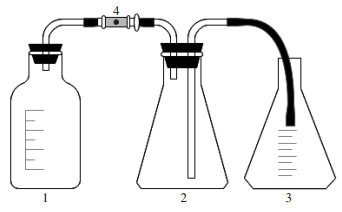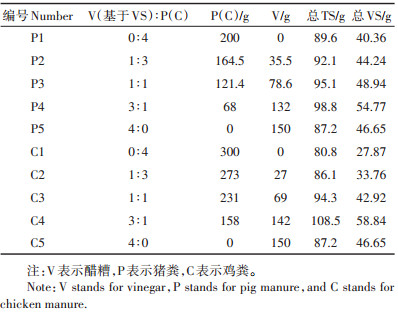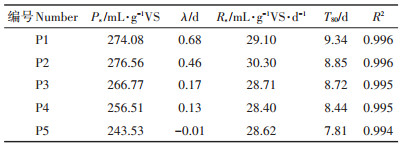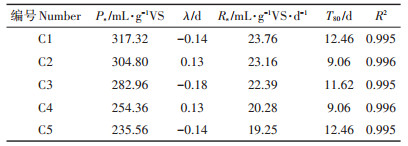2. 中国科学院广州能源研究所, 广州 510640
2. Guangzhou Institute of Energy Conversion, Chinese Academy of Sciences, Guangzhou 510640, China
醋糟(Vinegar,V)是制醋过程中的副产物,其主要成分为木质纤维素类物质,同时含有大量未降解的淀粉、蛋白质、粗纤维和非蛋白氮等组分,干物料中主要含有纤维素(20%~35%)、半纤维素(15%~25%)、木质素(15%~25%)、粗蛋白(6%~14%)、粗脂肪(2%~ 10%)及灰分(4%~10%)等成分,具有较高的利用价值[1-3]。山西省作为食醋大省,年产醋糟量在300万t左右[4],江苏镇江的醋糟年产量在260万t左右[5]。传统的醋糟处理方式大多是直接填埋处理,但是醋糟酸度大、腐烂慢等特性易对环境造成严重污染[5],同时也造成营养物质的极大浪费。近年来越来越多的学者开始探寻更加高效的利用醋糟的方法[6-9]。厌氧发酵可通过微生物的代谢,将废弃物转化为CH4和H2等能源性物质,实现资源的高效化利用[10]。如刘瑞光等[11]发现醋糟在厌氧发酵产H2时,最大H2含量可达70%;Li等[12]发现使用醋糟厌氧发酵产CH4时,产CH4速率最高可达581.88 mL·L-1;Ran等[13]通过水热预处理的方法,发现160 ℃处理后的醋糟CH4产量最高,为102.5 mL·kg-1。大量研究显示醋糟可以通过厌氧发酵的方式,实现资源化利用[14-15],但其中多采用单一原料进行厌氧发酵。
由于醋糟属于高纤维原料,作为单一原料厌氧发酵时,体系启动慢且极易酸化,而作为沼气发酵主要原料的畜禽粪便,猪粪及鸡粪均具有较高厌氧发酵的潜力,同时由于其较高的氮含量,具有较强的缓冲性能[16-20]。因此通过混合发酵的方式以促进物料之间的协同作用提高厌氧消化效率,同时提高醋糟的厌氧消化利用效率。Macias-Corral M等[21]发现牛粪与棉花混合发酵后总固体含量(TS)去除率显著高于单一物料(9%和16%);周莎等[22]发现鸡粪与小麦秸秆混合比例为5:5时单位CH4产气量达90.56 mL·g-1VS;贾志莉等[23]通过醋糟与酱糟混合发酵,累积CH4产量相较于理论值最高可以提升16%。
截至目前,以醋糟与畜禽粪便为原料的混合发酵研究较少,因此本研究分别以猪粪和鸡粪与醋糟为原料,进行中温批式混合厌氧发酵,测定各试验组产气特性及发酵体系的稳定性等,确定不同混合原料的最佳物料配比,以期为醋糟混合厌氧发酵提供科学依据。
1 材料与方法 1.1 试验原料 1.1.1 发酵原料试验所需醋糟取自江苏省某醋业加工企业,贮存于4 ℃冰箱冷藏;鸡粪和猪粪分别取自常州市某现代农业产业园,去除其中石块、羽毛等杂物后贮存于4 ℃冰箱冷藏。
1.1.2 接种物接种物采用猪粪、自来水以及厌氧发酵罐的沼液(用于醋糟发酵)调配而成,TS为2%左右,在进行约1个月的发酵之后开始驯化工作。厌氧污泥驯化过程中,前期通过每日添加醋糟进行驯化。起始发酵罐的总添加量为20 g·d-1,驯化时间为82 d,醋糟最终添加量为60 g·d-1。接种物各项指标见表 1。
|
|
表 1 接种物物理化学性质 Table 1 The physical and chemical properties of the inoculants |
发酵原料为猪粪、鸡粪和醋糟,其物理化学性质如表 2所示。根据物料的C/N,本试验基于挥发性固体(Volatile solid,VS)设置5个试验组,各比例设置1组重复,试验设计参数如表 3所示,猪粪组的接种量设定为70%,鸡粪组为80%。其中较高的接种量不仅可以维持系统较强的缓冲性能,降低试验中挥发性脂肪酸的积累[24-25],也可以缩短微生物生长的延滞期,快速启动试验。试验启动后,每日使用排水集气法测定产气量,同时定时测量排水量以及气体成分。每隔6 d取沼液样测定VFAs、TAN浓度等。
|
|
表 2 物料基础特性 Table 2 Characterization of raw materials |
|
|
表 3 试验设计参数 Table 3 Experimental design parameters |
试验所用发酵瓶体积为1.2 L,有效体积为1 L,试验在水浴锅中进行,温度为37±1 ℃,装置如图 1所示。

|
1.厌氧发酵罐;2.排水集气瓶;3.液体收集瓶;4.取气口 1.Anaerobic fermentation tank; 2.Drainage gas collection bottle; 3.Liquid collection bottle; 4. Sampling window 图 1 批式试验装置图 Figure 1 Schematic diagram of the batch experiment |
TS、VS采用差值法测定[26];纤维素、半纤维素和木质素采用范式法测定[27];C/N通过采用Vario EL cube元素分析仪测定;CH4和CO2含量采用气相色谱测定:载气为N2,柱箱和检测器温度为100 ℃,共运行5 min;VFAs采用气相色谱测定:载气为N2,程序升温设定为80 ℃停留2 min,以15 ℃·min-1的速度升温至250 ℃,共运行15.6 min;TAN采用纳氏试剂法测定(HJ 535—2009);pH使用梅特勒FE20-K PLUS酸度计测定。
1.5 数据处理累积甲烷产量采用Modified Gomperts对数据进行拟合[28],见公式(1)。

|
(1) |
式中:M (t)为t时每克VS物料的产甲烷量,mL·g-1VS;Ps为每克VS物料的最大产甲烷量,mL·g-1VS;Rs为每克VS物料最大产甲烷速率,mL·g-1VS·d-1;λ 为延滞期,d。
为了更好地表现混合发酵的协同效果,将试验数据进行以下处理:将纯醋糟组和纯粪便组的累积产甲烷量,按照3个混合物料组中两种物料的VS配比,计算出混合物料组的累积产甲烷量,该值记为理论累积产甲烷量m′;各混合物料组的试验所得累积产甲烷量记为实际产甲烷量m。协同增益产气率ω (%)的计算公式为:

|
(2) |
如图 2a所示,各试验组均能在较短时间内开始产气,其中P1在第5 d达到产气高峰为35 mL·g-1VS· d-1,P2、P3、P4、P5均在第2 d达到最高产气率,依次为32、39、46、50 mL·g-1VS·d-1。接种物中的微生物经过醋糟的长时间驯化,在消化利用发酵原料的时候,会优先选择醋糟,因此有醋糟占比的试验组启动相对较快;而猪粪在直肠消化过程中,经过了大肠杆菌、沙门氏菌和乳酸杆菌等菌群的消化作用,可被产酸菌直接利用的营养物质较少,大部分营养物质需要经过水解过程,将大分子转化成小分子[29],所以产气速度较慢。

|
图 2 醋糟与猪粪混合厌氧发酵产甲烷速率及甲烷含量随时间的变化 Figure 2 The variation of methane production rate and the methane content over time with co-digestion of vinegar residue and pig manure |
随后,各组产甲烷速率出现下降趋势,其中P1为持续下降,到第19 d,下降至1.5 mL·g-1VS·d-1左右,直到产气结束。由于猪粪中营养物质较为单一,在厌氧发酵过程进入产气阶段后,其消化速度较快,因此会出现不断下降的趋势。P2、P3、P4、P5的差异出现在第2 d到第7 d;其中P2从第2 d到第7 d下降幅度较小,从32 mL·g-1VS·d-1下降到28 mL·g-1VS·d-1,P3、P4、P5的产气速率下降到第5 d左右出现回升,到第7 d达到最高,分别为26、24、24 mL·g-1VS·d-1。醋糟中含有大量的木质纤维类物质等(总量75.7% ± 0.2%),这部分营养物质在厌氧消化过程中需要一段时间的软化、释放等过程[30-31],所以在醋糟占比较高的组分(P3、P4和P5)会出现产气速率的回升,这与秸秆类等含有较高木质纤维类物质的发酵现象相似[32-33];P2猪粪占比较高,在下降过程中,由于猪粪完成了营养物质由大分子向小分子的转化过程,所以下降幅度较小。之后P2、P3、P4和P5保持2 d的大幅下降到10 mL·g-1VS·d-1,然后开始缓慢下降,第19 d下降至1.5 mL·g-1VS·d-1左右,直到产气结束。原料混合对产气速率的影响主要出现在第2~7 d,第2 d的产气峰值随醋糟的占比增加而提高,下降过程中受猪粪厌氧消化速度较醋糟慢的影响,产气速率下降相对较慢。
各组甲烷含量如图 2b所示,P2、P3、P4、P5在第2 d甲烷含量就达到57%左右并保持稳定,P1则在第5 d增加至55%以上。从第7 d开始,各组甲烷含量出现下降,保持在54%左右,直到第12 d又出现上升,之后各组的甲烷含量保持在57%左右直到试验结束。试验过程中第7 d各组甲烷含量出现明显下降是由于在厌氧发酵初期,有机物在产酸型细菌的作用下转化为乙酸(150~600 mg·L-1)、丙酸(3500~5200 mg· L-1)等挥发性脂肪酸,其不断积累使得体系中产甲烷型细菌的活性受到一定程度的抑制,其中丙酸浓度超过1000 mg·L-1就会对产甲烷菌产生较为明显的抑制[34]。
随着体系中厌氧发酵的不断运行,VFAs不断地被产甲烷菌消耗利用,因此整个发酵系统的VFAs含量下降,同时甲烷含量恢复至57%±1%,直到试验结束。试验稳定阶段各组甲烷含量并没有较为明显的差距,说明混合发酵对于甲烷含量并无明显影响。
2.1.2 累积产甲烷量及其协同增益产气率通过Modified Gomperts模型拟合醋糟与猪粪混合厌氧发酵累积产甲烷量,结果如图 3a所示,模拟参数如表 4所示。各组R2在0.994~0.996之间,表明Modified Gomperts模型可较好地反映醋糟与猪粪混合发酵产甲烷的过程。其中,T80(达到最高累积产气量80%所需时间)随着猪粪占比的增加而延长,λ 的变化趋势与T80相似。由于猪粪厌氧发酵过程中,需要将大分子转化为小分子,所需要的时间相对较长,启动时间也相对较长,所以T80和λ 随猪粪占比的增加而延长,由于各组接种量较大且接种物经过较长时间的驯化等原因,其厌氧发酵均启动较快,延滞期λ均小于1 d。

|
图 3 醋糟与猪粪混合发酵累积产甲烷量及协同增益产气率 Figure 3 The cumulative methane production and the synergistic gain in methane production rate by co-digestion of vinegar residue and pig manure |
|
|
表 4 醋糟与猪粪混合发酵累积产甲烷量Modified Gomperts模拟参数 Table 4 The Modified Gomperts modeling parameters for the co-digestion of vinegar and pig manure |
Ps和Rs随着猪粪占比的提高而增大,当醋糟与猪粪配比为3:1时,Ps和Rs出现最高值分别为276.56 mL·g-1VS和30.30 mL·g-1VS·d-1,相较于P1和P5分别提高了0.9%、13.6%和4.1%、5.9%,表明醋糟与猪粪混合后进行厌氧发酵,产甲烷潜力随猪粪占比的提高而增加。各试验组的结果差距较小,这可能与试验所用原料的量较少有关。
如图 3b所示,3个试验组的协同增益产气率在第1~2 d达到最高,其中P2、P3、P4最高协同增益产气率分别为67.97%、52.88%和8.33%;之后随着试验的进行出现明显下降趋势;试验进行到第8 d时,各组协同增益产气率逐渐趋于平稳,且均保持在一个相对稳定的范围,P2、P3、P4分别在7.1%~9.2%、5.2%~5.8%及3.0%~3.5%的范围内,平均值分别为7.71%、5.43%及3.19%。各试验组协同增益产气率均为正值,说明混合发酵可以使原料得到更加充分的利用;同时P2 > P3 > P4,混合厌氧发酵原料之间的协同性大小随猪粪占比的增加而提高,尤其当醋糟与猪粪配比为1:3时,混合发酵协同性最佳。
2.2 醋糟与鸡粪混合厌氧发酵 2.2.1 产甲烷速率及甲烷含量的变化规律如图 4a所示,各组试验均能在短时间内开始产气,并在第3~4 d达到产气高峰,随后出现缓慢下降的趋势。各组在下降过程中出现了2种情况:C1、C2、C3和C4在第7 d下降到14 mL·g-1VS·d-1左右后进入了短时间的稳定阶段,随后从第11 d开始再次下降,下降时间点随着鸡粪占比的提高而延后;C5下降到第5 d,产气速率开始出现回升,第8 d到最高为21 mL·g-1VS·d-1,随后开始下降。各组再次出现下降趋势之后,到第18 d产气速率均下降至2 mL·g-1VS·d-1,直至试验结束。

|
图 4 醋糟与鸡粪混合发酵产甲烷速率及甲烷含量随时间的变化 Figure 4 The variation of methane production rate and the methane content over time with co-digestion of vinegar residue and chicken manure |
醋糟与鸡粪混合后对产气速率的影响主要表现在最高产气速率和从第8 d之后出现的产气速率下降的时间点上。产气峰值随鸡粪占比的增加而提高(C1 > C2 > C3 > C4 > C5),分别为39、37、33、31、29 mL· g-1VS·d-1。这是由于鸡粪中含有大量可直接被微生物利用的碳水化合物和蛋白质等,厌氧发酵启动较快。第8 d之后出现的产气速率下降时间点随鸡粪占比的增加而延后现象,是由于鸡粪在厌氧发酵过程中蛋白质等物质大多转化成了NH4+-N[35],含鸡粪的试验组氨氮含量由初始的1000±80 mg·L-1升高到2200± 300 mg·L-1,对产甲烷菌的厌氧消化作用产生负面影响[36]。
如图 4b所示,各组的甲烷含量在3~5 d内达到57%~62%,并保持相对稳定。从第10 d开始,各组甲烷含量出现明显的差异,其中C1、C2、C3和C4甲烷含量出现小幅提高,到第13 d升至65%左右,随后C1和C2保持在65%~67%之间,直到产气结束,C3和C4出现下降,至第25 d左右,下降至约55%,之后甲烷含量保持在55%~60%之间,直到产气结束;C5甲烷含量从第9 d开始下降,到第15 d下降到55%左右,之后保持在55%~58%之间,直到产气结束。
在厌氧发酵过程中由于产酸过程会生成大量的挥发性脂肪酸,pH下降,产甲烷菌受到pH变化的影响,甲烷含量出现下降(这一点在醋糟与猪粪混合厌氧发酵试验中也体现)。醋糟与鸡粪混合厌氧发酵第10 d各组乙酸含量在5000~7000 mg · L-1,丙酸在2000~3000 mg·L-1,C1、C2、C3和C4的发酵原料中含有一定占比的鸡粪,在厌氧发酵过程中由于蛋白质等物质转化为NH4+-N,对pH的变化有一定的缓冲能力,因此pH维持在7.2±0.25,体系维持在产甲烷菌适宜pH(6.5~7.8)的范围之内[37]。由各组数据可以看出挥发性脂肪酸对甲烷含量的影响随着鸡粪占比的提高而减小。
2.2.2 累积产甲烷量及其协同增益产气率通过Modified Gomperts模型拟合醋糟与鸡粪混合厌氧发酵累积产甲烷量结果如图 5a所示,模拟参数如表 5所示,各组R2在0.995~0.996,表明模拟结果可较好反映醋糟与鸡粪的混合厌氧发酵过程。在混合厌氧发酵过程中由于物料配比的改变,T80一般会呈现出一定的规律性(随一种物料的配比递增或者递减)[39-41],但本研究中T80并未表现出一定的规律性,这可能是在醋糟与鸡粪混合厌氧发酵的不同阶段中,由于挥发性脂肪酸和氨氮等抑制因素的存在,对产甲烷菌的生物活性造成不同程度的抑制,使产气阶段出现不同程度的延后现象。

|
图 5 混合发酵协同增益产气率 Figure 5 The cumulative methane production and the synergistic gain in methane production rate by co-digestion of vinegar residue and chicken manure |
|
|
表 5 醋糟与鸡粪混合厌氧发酵Modified Gomperts模拟参数 Table 5 The Modified Gomperts modeling parameters for the co-digestion of vinegar and chicken manure |
Ps和Rs大小依次为C1 > C2 > C3 > C4 > C5,其中C1的Ps和Rs分别为317.32 mL·g-1VS和23.76 mL·g-1VS· d-1,分别较C2、C3、C4和C5提高了4.11%、12.14%,24.75%、34.71%,2.59%、6.11%,17.16%、23.43%。由于鸡粪中含有大量的蛋白质、碳水化合物等营养物质[38];而醋糟的木质纤维类物质含量较高,可用于厌氧发酵的物质相对较少,因此在厌氧发酵过程中经过产甲烷菌的消化作用,鸡粪会产生更多的甲烷气体。
3个试验组的协同增益产气率如图 5b所示,在试验前16 d波动较大,其中C2的平均增长率为4.6%,C3为-0.7%,C4为-14.1%。之后各组进入相对稳定阶段,C2、C3、C4增长率分别处于2.2%~3.3%、-0.4%~ 3.2%、- 4.2%~ - 0.9%之间,平均值依次为2.8%、1.9%、-1.5%。3个试验组的协同增益产气率随醋糟占比的增加而提高,表明醋糟与鸡粪混合厌氧发酵的协同性随醋糟含量的增加而提高。但是由于鸡粪具有较好的发酵效果(其产甲烷潜力为同组最高),在与醋糟共发酵过程中,物料间的协同性相对并不高。
3 结论与建议(1)醋糟与猪粪混合厌氧发酵配比为1:3时,协同增益产气率以及产甲烷潜力均为各组最高,分别为7.71%和286.51 mL·g-1VS。采用醋糟与猪粪进行厌氧发酵生产沼气,建议配比为1: 3,且TS含量建议控制在15%以下,防止系统黏稠度过高,影响发酵效果。
(2)醋糟与鸡粪混合厌氧发酵配比为1:3时,协同增益产气率以及产甲烷潜力均为各组最高,分别为2.8%和312.57 mL·g-1VS。采用鸡粪进行厌氧发酵生产沼气,建议在较低负荷下进行,防止氨氮浓度过高,使发酵体系崩溃。若要进行较高负荷,建议添加适量C含量较高的物料,以调节发酵体系的C/N。
| [1] |
田波, 赵顺华, 张俊红, 等. 醋糟资源化利用研究进展[J]. 中国酿造, 2017, 36(3): 1-4. TIAN Bo, ZHAO Shun-hua, ZHANG Jun-hong, et al. Research advance on utilization of vinegar residue[J]. China Brewing, 2017, 36(3): 1-4. |
| [2] |
周云龙, 许之扬, 赵明星, 等. 醋糟高效厌氧消化体系构建[J]. 环境科学, 2017, 38(10): 4340-4347. ZHOU Yun-long, XU Zhi-yang, ZHAO Ming-xing, et al. Construction of a high efficiency anaerobic digestion system for vinegar residue[J]. Environmental Science, 2017, 38(10): 4340-4347. |
| [3] |
张建新, 张阅军, 杨致玲, 等. 糟渣类饲料的开发与利用:醋糟最佳发酵条件试验[J]. 饲料研究, 2002(1): 24-26. ZHANG Jian-xin, ZHANG Yue-jun, YANG Zhi-ling, et al. Development and utilization of dregs-based feed:Experimental optimization of fermentation conditions for vinegar dregs[J]. Feed Research, 2002(1): 24-26. DOI:10.3969/j.issn.1002-2813.2002.01.008 |
| [4] |
杨庆文, 彭晓光, 杨林娥, 等. 醋糟的开发与利用[J]. 山西农业科学, 2009, 37(2): 44-46. YANG Qing-wen, PENG Xiao-guang, YANG Lin-e, et al. The utilisation of vinegar-waste[J]. Journal of Shanxi Agricultural Sciences, 2009, 37(2): 44-46. DOI:10.3969/j.issn.1002-2481.2009.02.013 |
| [5] |
陈晓寅, 王振斌, 马海乐, 等. 醋糟的利用现状及前景[J]. 中国酿造, 2010(10): 1-4. CHEN Xiao-yin, WANG Zhen-bin, MA Hai-le, et al. Situation and prospect of the utilization of vinegar residue[J]. China Brewing, 2010(10): 1-4. DOI:10.3969/j.issn.0254-5071.2010.10.001 |
| [6] |
杨运克, 朱咏莉, 李萍萍. 醋糟纤维素分解菌的筛选与环境适应性研究[J]. 江苏农业科学, 2009(6): 410-412. YANG Yun-ke, ZHU Yong-li, LI Ping-ping. Isolation and screening of cellulose-decomposing microorganisms and their adaptability to environmental factors[J]. Jiangsu Agricultural Sciences, 2009(6): 410-412. DOI:10.3969/j.issn.1002-1302.2009.06.173 |
| [7] |
张金红.重组外切纤维素酶枯草杆菌的构建及其在醋糟发酵中的应用[D].镇江: 江苏大学, 2012. ZHANG Jin-hong. Construction of recombinant exocellulase Bacillus subtilis and its application in vinegar fermentation[D]. Zhenjiang: Jiangsu University, 2012. http://www.wanfangdata.com.cn/details/detail.do?_type=degree&id=Y2092732 |
| [8] |
王立群, 陈兆生. 醋糟间歇气化制备燃气试验[J]. 天然气工业, 2014, 34(3): 147-152. WANG Li-qun, CHEN Zhao-sheng. An experimental study of a fuel gas produced from vinegar residue through biomass intermittent gasification[J]. Natural Gas Industry, 2014, 34(3): 147-152. DOI:10.3787/j.issn.1000-0976.2014.03.025 |
| [9] |
冯璐.食醋工业废弃物厌氧消化性能及预处理技术研究[D].北京: 北京化工大学, 2013. FENG Lu. Study on anaerobic digestion performance and pretreatment technology of vinegar industrial waste[D]. Beijing: Beijing University of Chemical Technology, 2013. http://cdmd.cnki.com.cn/Article/CDMD-10010-1013266403.htm |
| [10] |
陈琳, 李东, 文昊深, 等. 蔬菜废弃物中温厌氧发酵酸化失稳预警指标筛选[J]. 农业工程学报, 2017, 33(1): 225-230. CHEN Lin, LI Dong, WEN Hao-shen, et al. Screening of early warning indicators of instability in anaerobic digestion of vegetable waste under mesophilic condition[J]. Transactions of the Chinese Society of Agricultural Engineering, 2017, 33(1): 225-230. |
| [11] |
刘瑞光, 马海乐, 王振斌, 等. 初始pH值对醋糟厌氧发酵产氢的影响[J]. 中国酿造, 2009(2): 71-73. LIU Rui-guang, MA Hai-le, WANG Zhen-bin, et al. Effect of initial pH on hydrogen production from vinegar residue[J]. China Brewing, 2009(2): 71-73. DOI:10.3969/j.issn.0254-5071.2009.02.022 |
| [12] |
Li L, Feng L, Zhang R, et al. Anaerobic digestion performance of vinegar residue in continuously stirred tank reactor[J]. Bioresource Technology, 2015, 186(1): 338-342. |
| [13] |
Ran G, Li D, Zheng T, et al. Hydrothermal pretreatment on the anaerobic digestion of washed vinegar residue[J]. Bioresource Technology, 2017, 248: 265-271. |
| [14] |
Lu F, Li Y Q, Chang C, et al. Biochemical methane potential(BMP) of vinegar residue and the influence of feed to inoculum ratios on biogas production[J]. Bioresources, 2013, 8(2): 2487-2498. |
| [15] |
侯雨, 林聪, 王阳, 等. 醋糟厌氧发酵特性的研究[J]. 可再生能源, 2011, 29(2): 85-88. HOU Yu, LIN Cong, WANG Yang, et al. Study on anaerobic fermentation characteristics of vinegar residue[J]. Renewable Energy Resources, 2011, 29(2): 85-88. DOI:10.3969/j.issn.1671-5292.2011.02.019 |
| [16] |
Wang X J, Yang G H, FengY Z, et al. Potential for biogas production from anaerobic codigestion of dairy and chicken manure with corn stalks[J]. Advanced Material Research, 2012, 347-353: 2484-2492. |
| [17] |
Mata-Alvarez J, Dosta J, Macé S, et al. Co-digestion of solid wastes:A review of its uses and perspectives including modeling[J]. Critical Reviews in Biotechnology, 2011, 31(2): 99-111. |
| [18] |
Pagés D J, Pereda R I, Lundin M, et al. Co-digestion of different waste mixtures from agro-industrial activities:Kinetic evaluation and synergetic effects[J]. Bioresource Technology, 2011, 102(23): 10834-10840. DOI:10.1016/j.biortech.2011.09.031 |
| [19] |
Pastor L, Ruiz L, Pascual A, et al. Co-digestion of used oils and urban landfill leachates with sewage sludge and the effect on the biogas production[J]. Applied Energy, 2013, 107: 438-445. DOI:10.1016/j.apenergy.2013.02.055 |
| [20] |
Kafle G K, Sang H K. Anaerobic treatment of apple waste with swine manure for biogas production:Batch and continuous operation[J]. Applied Energy, 2013, 103(1): 61-72. |
| [21] |
Macias-Corral M, Samani Z, Hanson A, et al. Anaerobic digestion of municipal solid waste and agricultural waste and the effect of co-digestion with dairy cow manure[J]. Bioresource Technology, 2008, 99(17): 8288-8293. DOI:10.1016/j.biortech.2008.03.057 |
| [22] |
周莎, 王晓娇, 张彤, 等. 鸡粪与麦秆混合厌氧发酵环境中各因子响应关系研究[J]. 环境科学学报, 2016, 36(3): 932-939. ZHOU Sha, WANG Xiao-jiao, ZHANG Tong, et al. Responsive relationship among factors influencing the anaerobic co-digestion of chicken manure and wheat straw[J]. Acta Scientiae Circumstantiae, 2016, 36(3): 932-939. |
| [23] |
贾志莉, 初永宝, 师晓爽, 等. 酱糟与醋糟混合发酵产沼气研究[J]. 环境科学学报, 2013, 33(7): 1947-1952. JIA Zhi-li, CHU Yong-bao, SHI Xiao-shuang, et al. Biogas production of sauce and vinegar residues by anaerobic co-digestion[J]. Acta Scientiae Circumstantiae, 2013, 33(7): 1947-1952. |
| [24] |
Hill D T, Cobb S A, Bolte J P, et al. Using volatile fatty acid relationships to predict anaerobic digester failure[J]. Trans AsAE, 1987, 30(2): 496-501. DOI:10.13031/2013.31977 |
| [25] |
Ahring B K, Sandberg M, Angelidaki I. Volatile fatty acids as indicators of process imbalance in anaerobic digestors[J]. Applied Microbial Biotechnology, 1995, 43: 559-565. DOI:10.1007/BF00218466 |
| [26] |
Walter W G. APHA Standard methods for the examination of water and wastewater[J]. American Journal of Public Health & the Nations Health, 1998, 56(3): 387. |
| [27] |
Van Soest P J. Use of detergents in the analysis of fibrous feeds. Ⅱ. A rapid method for the determination of fiber and lignin[J]. Journal of the Association of Official Analytical Chemistry, 1963, 46: 829-835. |
| [28] |
Nopharatana A, Pullammanappallil P C, Clarke W P. Kinetics and dynamic modelling of batch anaerobic digestion of municipal solid waste in a stirred reactor[J]. Waste Management, 2007, 27(5): 595-603. DOI:10.1016/j.wasman.2006.04.010 |
| [29] |
王晓娇.混合原料沼气厌氧发酵影响因素分析及工艺优化[D].杨凌: 西北农林科技大学, 2013. WANG Xiao-jiao. Analysis of factors affecting anaerobic fermentation of mixed raw materials and process optimization[D]. Yangling: Northwest A&F University, 2013. http://cdmd.cnki.com.cn/Article/CDMD-10712-1013347294.htm |
| [30] |
Schober G, Trösch W. Degradation of digestion residues by lignolytic fungi[J]. Water Research, 2000, 34(13): 3424-3430. DOI:10.1016/S0043-1354(00)00076-2 |
| [31] |
Myint M, Nirmalakhandan N, Speece R E. Anaerobic fermentation of cattle manure:Modeling of hydrolysis and acidogenesis[J]. Water Research, 2007, 41(2): 323-332. |
| [32] |
周岭, 李文哲. 废弃秸秆生物气化的实验研究[J]. 农机化研究, 2004(1): 182-183. ZHOU Ling, LI Wen-zhe. A study on refused straw pole gasified by microbe[J]. Journal of Agricultural Mechanization Research, 2004(1): 182-183. DOI:10.3969/j.issn.1003-188X.2004.01.065 |
| [33] |
陈佳一, 雷中方. 稻草秸秆厌氧发酵接种物的驯化初步研究[J]. 复旦学报(自然科学版), 2008, 47(5): 652-658. CHEN Jia-yi, LEI Zhong-fang. Preliminary study on inoculum acclimation for anaerobic digestion of rice straw[J]. Journal of Fudan University (Natural Science), 2008, 47(5): 652-658. |
| [34] |
Batstone D J, Keller J, Angelidaki I, et al. The IWA anaerobic digestion model No 1(ADM1)[J]. Water Science & Technology, 2002, 45(10): 65-73. |
| [35] |
周晓臣.城镇有机垃圾厌氧发酵中有机酸及氨氮抑制效应研究[D].重庆: 重庆大学, 2006. ZHOU Xiao-chen. Study on the inhibitory effect of organic acids and ammonia nitrogen in anaerobic fermentation of municipal organic waste[D]. Chongqing: Chongqing University, 2006. http://cdmd.cnki.com.cn/Article/CDMD-10611-2006149502.htm |
| [36] |
Koster I W, Lettinga G. Anaerobic digestion at extreme ammonia concentrations[J]. Biological Wastes, 1988, 25(1): 51-59. DOI:10.1016/0269-7483(88)90127-9 |
| [37] |
Majd S S, Abdoli M A, Karbassi A, et al. Effect of physical and chemical operating parameters on anaerobic digestion of manure and biogas production:A review[J]. Journal of Environmental Health and Sustainable Development, 2017, 2(1): 231-244. |
| [38] |
刘战广, 朱洪光, 王彪, 等. 粪草比对干式厌氧发酵产沼气效果的影响[J]. 农业工程学报, 2009, 25(4): 196-200. LIU Zhan-guang, ZHU Hong-guang, WANG Biao, et al. Effect of ratios of manure to crop on dry anaerobic digestion for biogas production[J]. Transactions of the Chinese Society of Agricultural Engineering, 2009, 25(4): 196-200. |
| [39] |
吕丹丹, 席北斗, 李秀金, 等. 不同混合比牛粪玉米秸中温干发酵产沼性能[J]. 环境工程学报, 2012, 6(6): 2055-2060. LÜ Dan-dan, XI Bei-dou, LI Xiu-jin, et al. Mesophilic dry anaerobic digestion biogas performance of different mix ratios of cow manure and corn straw[J]. Techniques and Equipment for Environmental Pollution Control, 2012, 6(6): 2055-2060. |
| [40] |
楚莉莉, 李轶冰, 冯永忠, 等. 猪粪麦秆不同比例混合厌氧发酵特性试验[J]. 农业机械学报, 2011, 42(4): 100-104. CHU Li-li, LI Yi-bing, FENG Yong-zhong, et al. Characteristics of co-digestion of pig dung and wheat straw in various ratios[J]. Transactions of the Chinese Society for Agricultural Machinery, 2011, 42(4): 100-104. |
| [41] |
李跻, 郭旭宏. 鸡粪的发酵处理方法与利用[J]. 农业科学研究, 2007, 28(3): 97-98. LI Ji, GUO Xu-hong. Utilization and methods of the ermentation treatment of chicken excrement[J]. Journal of Agricultural Sciences, 2007, 28(3): 97-98. DOI:10.3969/j.issn.1673-0747.2007.03.027 |
 2019, Vol. 38
2019, Vol. 38







